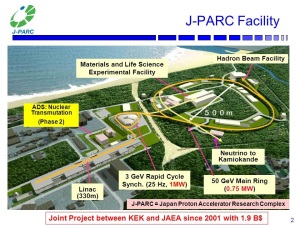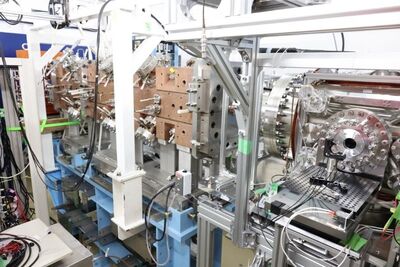
From J-PARC|Japan Proton Accelerator Research Complex (JP)
5.23.24
Executive summary
Question:
∗ If muons can be accelerated in an accelerator, it is expected to be useful in a variety of fields such as elementary particle physics, material and life sciences, and earth science. For example, such muons are useful for ultra-precise measurement of anomallous magnetic moment (g-2) and electric dipole moment (EDM) to study new theory beyond the standard model of elementary particles. But accelerating them is technically difficult.
Findings:
∗ Generally, muons created in an accelerator have large variations in direction and speed, making them unsuitable for acceleration. However, if a muon has a positive charge, it can be decelerated until it almost stops, and the direction and speed can be made uniform (cooled). For the first time in the world, the research group succeeded in accelerating a positive muon to approximately 4% of the speed of light.
Meaning:
∗ The research group demonstrated cooling and acceleration of positive muon for the first time after continuous development of cooling and acceleration technologies in the past. This is a major step towards enabling ultra-precise survey of physics beyond the standard model. In addition, this technology offers wide range of applications such as muon microscopy and other interdisciplinary research areas.

Figure 1. Cooling and accelerating a positive muon beam

Figure 2. Experimental set up for muon cooling and acceleration at the J-PARC Materials and Life Science Experimental Facility (MLF). A positive muon beam enters from the right side, is cooled in the muon cooling chamber on the right and is accelerated in the radio-frequency acceleration cavity on the left. The accelerated muon beam is measured by a diagnostics system at the exit of the acceleration cavity.
Overview
A muon is an elementary particle like an electron. Muons were first discovered in 1936 as cosmic rays falling from the sky. Natural muons originated from cosmic rays have been used to see through the interior of large and/or thick objects, such as pyramids. Presently, muons can be produced in much higher intensity using accelerators for the use of various research and applications.
Creation of muons in an accelerator is in three steps. First, protons are accelerated to near the speed of light. When the accelerated protons hit material such as graphite, they create particles called pions, which decay to form muons.
At J-PARC, the high intensity proton accelerator in Tokai village, Ibaraki prefecture, approximately 100 million muons are produced per second. However, the direction and speed of each muon in the beam are quite different. There are some experiments where it can be used as is. But it is not suitable for a new experiment to measure of muon g-2/EDM with ultra-precision.
There are two types of muons with a negative charge and a positive charge, and they have a particle/antiparticle relationship. A muon with a positive charge is called a positive muon, and it can be decelerated until it almost stops to align its direction and speed (cooling). After they come to a near stop, they are accelerated by an electric field. At the end of this process, they become a highly directional.
However, muons are difficult to accelerate because they do not have the same direction or speed. The acceleration cavity used for acceleration is like a narrow tube. If the directions are different, it will not be possible to efficiently put the muons into the tube. Also, if the speeds are widely distributed, the efficiency of acceleration will be poor.
At J-PARC, positive muons having a speed of about 30% the speed of light produced in a proton accelerator are shot into a material called silica aerogel. Positive muons combine with electrons in silica aerogel to form neutral atoms called muoniums. By irradiating the muonium with a laser to strip off an electron, we obtain positive muons that have been slowed down (cooled) to a nearly stopped velocity at around 0.002% of the speed of light.
After that, a radio-frequency electric field is applied to accelerate the positive muons. Since the positive muon is almost stationary, the more it accelerates, the more directional it becomes, creating a much more directional muon beam that can be used for a variety of applications.
A joint research group consisting of KEK, Okayama University, Nagoya University, Kyushu University, Ibaraki University, Japan Atomic Energy Agency, and Niigata University conducted an experiment at the muon experimental facility in the J-PARC MLF. By combining muon cooling technology and radio-frequency acceleration technology, the research group successfully demonstrated that positive muons accelerate to approximately 4% of the speed of light for the first time in the world.
Muons have a lifetime of only about 2 microseconds (2 millionths of a second), and if they are not accelerated quickly, they will decay. Also, since it is 200 times heavier than an electron, it will need to be accelerated in stages, the research group plans to continue developing the remaining parts of acceleration technology and eventually accelerate it to 94% of the speed of light.
With the initial part of the muon acceleration technology now demonstrated, the world’s first muon accelerator is now within sight. The year 2024 is the first year of muon acceleration. New research opportunities using accelerated muons will follow.
Research group
J-PARC center, Particle & Nuclear Physics Division,
Materials & Life Science Division Muon and Neutron group, Institute of Particle and Nuclear Studies, High Energy Accelerator Research Organization (KEK)
Muon Science Laboratory, Institute of Materials Structure Science, KEK
Accelerator Laboratory, KEK
Division of Quantum Universe, Research Institute for Interdisciplinary Science, Okayama University
Nagoya University, Graduate School of Science, Department of Physics, High Energy Physics Laboratory
Kobayashi-Maskawa Institute for the Origin of Particles and the Universe, Nagoya University
Experimental Particle Physics Laboratory, Department of Physics, Faculty of Science, Kyushu University
Research Center for Advanced Particle Physics, Kyushu University
Ibaraki University Graduate School of Science and Engineering, Institute of Quantum Beam Science, Elementary particle physics laboratory
Japan Atomic Energy Agency
High Energy Physics Laboratory, Faculty of Science, Niigata University
Quantum Research Center, Institute for Research Administration, Niigata University
See the full article here.
Comments are invited and will be appreciated, especially if the reader finds any errors which I can correct.
five-ways-keep-your-child-safe-school-shootings
Please help promote STEM in your local schools.
J-PARC (Japan Proton Accelerator Research Complex) is a high intensity proton accelerator facility. It is a joint project between KEK and Japan Atomic Energy Agency (JP) and is located at the Tokai campus of JAEA. J-PARC aims for the frontier in materials and life sciences, and nuclear and particle physics. J-PARC uses high intensity proton beams to create high intensity secondary beams of neutrons, hadrons, and neutrinos.
J-PARC includes three main parts: the 400 MeV proton linear accelerator, the 3 GeV Rapid Cycling Synchrotron (RCS), and the 30 GeV Main Ring (MR) synchrotron. There are two main experimental areas: the Materials and Life Science Experimental Facility (MLF), where the proton beam from the RCS is used to create beams of either neutrons or muons for further study, and the Hadron Facility (HD), where the beam from the main ring is used to create heavy hadronic particles such as pions and kaons. The main ring beam is also used to create neutrino beams for analysis at the Kamioka laboratory, located approximately 300 km to the west. A planned project also allow for research into accelerator-driven nuclear waste transmutation.
